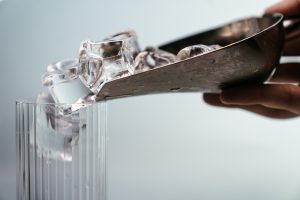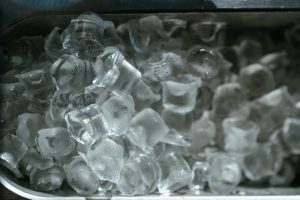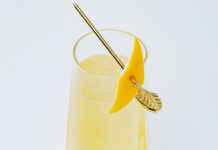Most people wouldn’t assume that cold temperatures could negatively affect a commercial ice machine. Ironically, cold temperatures, meaning 55 degrees and below, can significantly lower the amount of ice your ice machine produces, and in some cases, damage the unit altogether. 
Three major issues occur when temperatures drop considerably:
- Freeze Ups
- Frozen tubes or valves
- Component malfunctions
Freeze Ups
An ice machine freeze-up generally occurs when ice can’t release from your ice machine’s evaporator plate. An ice machine is designed to drop ice during every harvest cycle, but if an ice cube remains stuck to the evaporator plate, it can continue to grow with every freeze cycle. Eventually, the ice grows so big that it freezes over the evaporator plate, limiting the amount of ice produced each cycle.
You may be surprised to know that heat also plays an essential role in the ice machine’s ability to make a batch of ice. Many models use hot gas, produced during the ice making process, to loosen ice off the evaporator and into your ice machine’s storage bin. Many other models use warmer water to release the ice.
When temperatures drop close to freezing, the machine has a harder time heating the evaporator plate. When this happens, ice has a greater chance of becoming stuck on the evaporator plate.
In extreme situations, the ice can grow big enough to crack the evaporator plate (which carries a hefty repair cost).
Frozen Tubes and Valves
There are only two areas in your ice machine where you actually want to see ice: the evaporator plate and your machine’s storage bin. When water freezes anywhere else within the unit, it can spell disaster.
During the ice-making process, water flows from one area of the machine to another. Water from your water line enters the machine and runs through a series of pipes and valves. Eventually, the water makes its way to your ice machine’s evaporator plate, where it’s frozen into cubes.
If water freezes inside any of these distribution tubes or valves, it will block the flow of water to your evaporator. The lower the water flow, the less ice your ice machine will produce. This scenario will also lead to smaller or malformed ice cubes.
In extreme cases, water can expand within the tube or valve and crack it open, causing leaks within the machine that can lead to corrosion and structural damage.
Component Failures
Some components within your ice machine, like the thermistor or bin control, help to monitor the temperature throughout the ice-making process.
The thermistor (a device that acts as a thermometer) is just one of many components that help guide the ice-making process. It does this by reading the temperature coming from the ice machine’s evaporator plate. When the temperature reaches 48 degrees Fahrenheit, the machine begins a defrost timer set to stop the harvest cycle. Once that timer expires, the freeze cycle begins, producing the next batch of ice.
If the air around your ice machine is significantly cold, it takes longer for the thermistor to read a 48-degree temperature. This slows the ice-making process down, resulting in less ice for your business.
Thermostatic bin controls are common in many large ice machine models. These mechanisms use a thermostatic bulb to tell when the ice bin is full. The bulb extends down into your ice bin. As the bin fills, the ice level slowly rises toward the bulb. When the ice touches the bulb, it registers the drop in temperature and shuts off the ice maker.
Thermostatic bin controls operate just fine in temperatures above 50 degrees. Still, they can have a hard time measuring temperature drops if the air is already significantly cold. This results in the ice machine shutting down, even if the bin is empty.
How to Fight the Cold Temperatures
In most cases, merely raising the temperature in your business can rectify any problems associated with cold temperatures – but it’s not always that easy.
If the water line is frozen or the water entering the machine is too cold, insulating your pipes may be the best option. Insulating the lines may raise the water temperature just enough to avoid any significant issues from forming. If you live in an area with frigid winters, consider calling a plumber to help. 
Finally, a bad installation could be your culprit. Some business owners make the mistake of installing their commercial ice machines in a walk-in freezer. Many times, the owner is simply trying to save space. They don’t assume it will damage the machine because many home refrigerators have ice makers built into a refrigerator’s freezer compartment. Commercial ice machines are not built the same way as your home refrigerator, so it’s a mistake to assume they will operate the same way.
Suppose you’ve made the mistake of installing your ice machine in a walk-in freezer or an area where there is no temperature control. In that case, you should reinstall the machine somewhere warmer.
When thinking about ice machines, it’s best to follow the Goldilocks rule, not too hot, not too cold. You want conditions to be just right. For most models, you want the air around the unit to measure between 70 and 90 degrees. The incoming water should be between 50 and 70 degrees. Maintaining the temperature within these ranges and keeping up with preventive maintenance will keep your ice machine running efficiently year after year.








